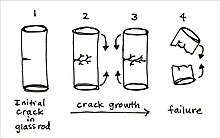Static fatigue
Static fatigue describes how prolonged and constant cyclic stress weakens a material until it breaks apart, which is called failure.[1] Static fatigue is sometimes called "delayed fracture".[2] The damage occurs at a lower stress level than the stress level needed to create a normal tensile fracture.[2] Static fatigue can involve plastic deformation[3] or crack growth.[4][5] For example, repeated stress can create small cracks that grow and eventually break apart plastic,[6] glass,[7] or ceramic[8] materials. The material reaches failure faster by increasing cyclic stress. Static fatigue varies with material type and environmental factors, such as moisture presence[9] and temperature.[10][11]
Applications
Static fatigue tests can estimate a material’s lifetime[12] and hardness to different environments.[13] However, measuring a static fatigue limit can take a long time, and it is hard to measure a material’s true static fatigue limit with full certainty.[12]
Typical occurrence

Stress corrosion cracking
Stress corrosion cracking (SCC) happens when a stressed material is in a corrosive (chemically destructive) environment.[14] One example of SSC embrittlement is when moisture increases static fatigue effects in glass.[15] SCC is also seen in hydrogen embrittlement,[16][17] embrittlement of some polymers,[18] and more.
Plastic Deformation (Plastic Flow)
Plastic deformation happens when stresses flatten, bend, or twist a material until it cannot return to its original shape.[19] This can create cracks in the material and decrease its lifetime ultimately leading to the deformation of plastic.[3]
Examples of Static Fatigue and Stresses on Materials
Plastic pipes under water or other fluids experience hydrodynamic forces that can result in fatigue.[20] The pipes reach failure sooner as temperatures and exposure to aggressive substances increase.[20] For static fatigue tests, rotating machines apply weight on the material under study causing it to bend in different directions, which weakens the material overtime.[21]
References
- ^ In Materials, Woodhead Publishing (2010). Guedes, Rui Miranda (ed.). Creep and Fatigue in Polymer Matrix Composites (1st ed.). Woodhead Publishing. ISBN 9780081014585.
- ^ a b Pelleg, Josh (2021). Cyclic Deformation in Oxides, Carbides, and Nitrides. Vol. 22. Springer. pp. 495–511. doi:10.1007/978-3-030-86118-6_15. ISBN 978-3-030-86118-6. S2CID 244421914.
- ^ a b Wang, G.S.; Blom, A.F. "Effect of Large Local Plastic Flow on the Fatigue Life of Metallic Materials". Aeronautics Division – via The Swedish Defence Research Agency.
- ^ Courtney, Thomas H. (2005-12-16). Mechanical Behavior of Materials: Second Edition. Waveland Press. ISBN 9781478608387.
- ^ Furmanski, J.; Rimnac, C.M. (2011). "Crack Propagation Resistance Is Similar Under Static and Cyclic Loading in Crosslinked UHMWPE: A Pilot Study". Clinical Orthopaedics and Related Research. 469 (8): 2302–2307. doi:10.1007/s11999-010-1712-y. PMC 3126950. PMID 21128033.
- ^ Crawford, Roy. J. (1998). Plastics Engineering (Chapter 1 - General Properties of Plastics) (1 ed.). Matthew Deans. pp. 1–40. ISBN 9780081007099.
- ^ Grutzik, S.J.; Strong, K.T.; Rimsza, J.M. (December 2022). "Kinetic model for prediction of subcritical crack growth, crack tip relaxation, and static fatigue threshold in silicate glass". Journal of Non-Crystalline Solids: X. 16 (100134): 100134. Bibcode:2022JNCSX..1600134G. doi:10.1016/j.nocx.2022.100134. S2CID 254308009.
- ^ Ruys, Andrew (2019). Processing, structure, and properties of alumina ceramics. Woodhead Publishing. pp. 71–121. doi:10.1016/C2017-0-01189-8. ISBN 978-0-08-102442-3.
- ^ Laughton, M.J.; Warne, D.J.; Tricker, R. (2003). Optical Fibres in Power Systems (16 ed.). Newnes. pp. 37–1, 37-3 – 37-17. doi:10.1016/B978-075064637-6/50037-X. ISBN 978-0-7506-4637-6.
- ^ Kingery, W.D. (1976). Introduction to ceramics. New York: Wiley. ISBN 978-0471478607.
- ^ Ebel, A.; Caty, O.; Rebillat, F. (2022). "Effect of temperature on static fatigue behavior of self-healing CMC in humid air". Composites Part A: Applied Science and Manufacturing. 157: 106899. doi:10.1016/j.compositesa.2022.106899. S2CID 247148726.
- ^ a b Wilkins, B.J.; Dutton, R. (March 1976). "Static Fatigue Limit with Particular Reference to Glass". Journal of the American Ceramic Society. 59 (3–4): 108–112. doi:10.1111/j.1151-2916.1976.tb09442.x.
- ^ Kelly, A.; Zweben, C.; Sims, G.D.; Broughton, W.R. (2000). Comprehensive Composite Materials (2.05 - Glass Fiber Reinforced Plastics—Properties). Vol. 2. Pergamon. pp. 151–197. doi:10.1016/B0-08-042993-9/00181-9. ISBN 978-0-08-042993-9.
- ^ Raja, V.S.; Tetsuo, Shoji (2011). Stress Corrosion Cracking. Woodhead Publishing. pp. 245–272. doi:10.1533/9780857093769.3.245. ISBN 978-1-84569-673-3.
- ^ Wiederhorn, S. M.; Bolz, L. H. (1970-10-01). "Stress Corrosion and Static Fatigue of Glass". Journal of the American Ceramic Society. 53 (10): 543–548. doi:10.1111/j.1151-2916.1970.tb15962.x. ISSN 1551-2916.
- ^ Lou than, M.R. "Hydrogen Embrittlement - Office of Scientific and Technical Information" (PDF).
- ^ Murakami, Y.; Kanezaki, T.; Matsuoka, S. (2008). "Hydrogen Embrittlement Mechanism in Fatigue of Austenitic Stainless Steels". Metallurgical and Materials Transactions A. 39 (6): 1327–1339. Bibcode:2008MMTA...39.1327M. doi:10.1007/s11661-008-9506-5. S2CID 137234625.
- ^ Brown, Norman; Parrish, Mark F. (1974). Bishay, Adli (ed.). Recent Advances in Science and Technology of Materials. Springer US. pp. 1–13. doi:10.1007/978-1-4613-4538-1_1. ISBN 9781461345404.
- ^ Pfeifer, Michael (2009). "Chapter 6 - Degradation and Reliability of Materials". Materials Enabled Designs. Butterworth Heinemann. pp. 161–187. doi:10.1016/B978-0-7506-8287-9.00006-9. ISBN 978-0-7506-8287-9 – via Science Direct.
- ^ a b Farshad, Mehdi (2006-01-01), Farshad, Mehdi (ed.), "7 - Fatigue, corrosion, and wear", Plastic Pipe Systems, Oxford: Elsevier Science, pp. 153–165, ISBN 978-1-85617-496-1, retrieved 2023-04-15
- ^ Goodman, Soderberg (2022), "Fatigue", MET 301: Design for Cyclic Loading (PDF), New Jersey Institute of Technology, p. 1
